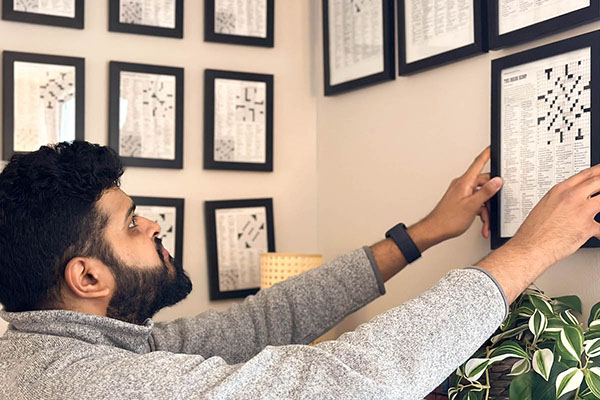Uncovering ‘the basis of humanity’ one puzzle at a time
MD/PhD student creates crosswords for major newspapers

In the world of word puzzles, Sid Sivakumar is a celebrity.
A graduate student working toward a medical degree and a PhD in biomedical engineering at Washington University in St. Louis, Sivakumar also authors crossword puzzle books and creates acclaimed crosswords for The New York Times, The Washington Post, The Wall Street Journal and the Los Angeles Times. In 2022, he was named the inaugural Wordle Champion after competing against 300 participants in a live version of the popular internet game at the American Crossword Puzzle Tournament in Stamford, Conn.
Last year, at Washington National Airport in Arlington, Va., a wide-eyed, older woman recognized Sivakumar from an online story about prominent crossword puzzle constructors, as they’re called. She approached Sivakumar at a boarding gate and gushed: “Are you the person who writes the hardest puzzles for The New York Times?”
Despite his celebrated puzzle-making and -solving talents, however, the puzzle Sivakumar finds most intriguing may be unsolvable. At least for now.
That puzzle — the human brain — brought Sivakumar to Washington University School of Medicine seven years ago to begin his MD/PhD program in neuroscience and biomedical engineering. Although neuroscience research and understanding have advanced rapidly over the last several decades, many aspects of the brain remain a mystery. However, Sivakumar figured the university’s reputation as a world leader in the neurosciences was his best bet for unraveling the brain’s intricacies.
The three-pound organ houses more than 100 billion cells that transmit electrical impulses responsible for consciousness, thoughts, behavior, intelligence, feelings and movements. “As a neuroscientist, I like to believe the human brain is the most powerful apparatus in the universe,” Sivakumar said. “The brain forms our overall perceptions of life.”
His research inside the university’s Jeffrey T. Fort Neuroscience Research Building probes stroke’s impact on the motor cortex, a crucial part of the brain that controls movement. Sivakumar also helps create electrode devices aimed at rehabilitating movement in stroke patients by interpreting their brain signals.
“I want my research to one day help the patients I treat who have suffered from strokes, epilepsy or other brain disorders,” said Sivakumar, 28, who is on track to earn his PhD from the McKelvey School of Engineering in April 2025 and his medical degree in spring 2027.
Read the full story here.



